I am announcing today a tax reform plan which will cut income tax for every Australian taxpayer from 1 July 2008.
For a family with the principal earner on average weekly earnings and the second income earner in part-time work (earning 40 per cent of average earnings) the income tax cut will be around $30 per week rising to $50 per week in 2010.
These tax cuts will deliver a cut of around $20 per week to a person currently on average weekly earnings from 1 July 2008 rising to around $35 per week from 1 July 2010.
These tax cuts are in addition to tax cuts that took effect on 1 July 2007. This plan to cut tax will boost family income and help families deal with cost of living pressures.
Tables which show the cumulative effect of tax relief are in Attachments A and B. For individuals above $75,000 the tax cuts shown from 1 July 2008 include those already legislated for 1 July 2008 but yet to take effect.
Tax Reform Plan
This tax reform plan which will result in a significant reduction in taxes for all individual taxpayers is a decisive reform that will build a world class competitive tax system while maintaining the sustainability of the revenue base. The reform provides even further incentives for low income workers to join in the workforce. As such this tax reform will boost capacity in the Australian economy.
From 1 July 2008:
- the Low Income Tax Offset (LITO) will increase from $750 to $1,200, providing an effective tax free threshold of $14,000 (up from $11,000) to those taxpayers eligible for the full LITO;
- the 30 per cent threshold will increase from $30,001 to $34,001; and
- the 40 per cent threshold will increase to $80,001 and the 45 per cent threshold will increase to $180,001, as announced in the 2007-08 Budget.
From 1 July 2009:
- the LITO will increase to $1,350, providing an effective tax free threshold for low income earners of $15,000;
- the 30 per cent threshold will increase to $35,001;
- the second top marginal rate will be cut from 40 to 38 per cent; and
- the top marginal rate will be cut from 45 to 43 per cent;
From 1 July 2010:
- the LITO will increase to $1,500, providing an effective tax free threshold for low income earners of $16,000;
- the 30 per cent threshold will increase to $37,001;
- the second top marginal rate will be cut from 38 to 37 per cent; and
- the top marginal rate will be cut from 43 to 42 per cent.
The rates scales resulting from this tax reform are shown in the table.


Senior Australians eligible for the senior Australians tax offset (SATO) and the LITO currently do not pay tax after assessment until they reach an annual income of $25,867 for singles and $21,680 for each member of a couple. From 1 July 2008, these income levels will be lifted to $28,867 for singles and $24,680 for each member of a couple. From 1 July 2009, these incomes levels will be lifted to $29,867 for singles and $25,680 for each member of a couple. By 2010-11, the income levels will be $30,685 for singles and $26,680 for each member of a couple.
The fringe benefits tax rate will also be reduced in line with reductions in the top marginal tax rate (including the Medicare levy), decreasing to 44.5 per cent from 1 April 2009 and to 43.5 per cent from 1 April 2010.
Our Tax Reform Goal
This tax plan is intended to build towards an ambitious new goal for Australia’s personal income tax system. The goal is that over five years by 2012-13 the personal income tax system will have the following features: -
- An enhanced low income tax offset (LITO) that will mean that low income earners will have an effective tax free threshold of at least $20,000;
- A rate scale of 15 per cent, 30 per cent, 35 per cent, and 40 per cent;
- Forty-five per cent of taxpayers1 facing a marginal tax rate of 15 per cent or less;
- Eighty-five per cent of taxpayers1 facing a marginal tax rate of 30 per cent or less; and
- Ninety-eight per cent of taxpayers1 facing a marginal tax rate of 35 per cent or less.
This goal can be met if the expected strong economic and fiscal conditions continue.
Tax Reform Plan
The tax reform plan announced today builds on the significant reductions in personal income tax for low and average income earners that have resulted from tax cuts delivered over the last five budgets. Chart 1 shows the net reductions in tax that will result over the forward estimates period.
Chart 1: Reductions in net income tax paid by low and average income earners
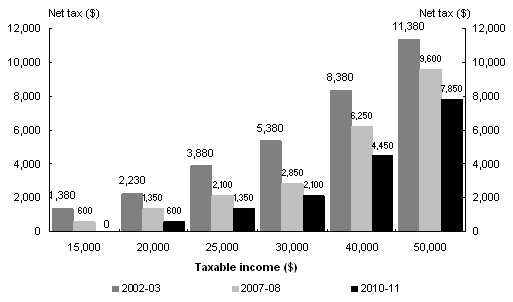
Attachments A and B show the reduction in income tax that will be provided for Australian individual taxpayers over a range of incomes. Attachment C shows the improvement in the real disposable incomes and net tax thresholds of families since 1996-97.
As shown in Chart 2 below, in percentage terms, the greatest tax cuts have been provided to low and average income earners.
Chart 2: Personal income tax savings since The New Tax System

This tax reform plan will continue the focus on encouraging workforce participation that has been a feature of this Government’s tax reform, with an additional 65,000 people expected to be encouraged into the workforce over the medium term.
Chart 3: Estimated cumulative workforce impacts
from personal tax scale changes*
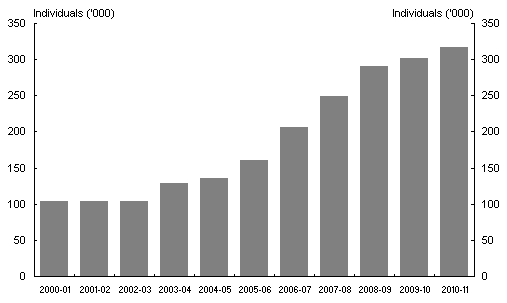
Source: Treasury version of the Melbourne Institute Tax and Transfer Simulator (MITTS).
*The actual workforce impacts are likely to be spread beyond the years of introduction of the tax scale changes.
These tax reforms will also assist in improving Australia’s competitiveness against other OECD countries.
Australia is a low tax country compared to the standards of the developed world — the eighth lowest in the OECD. With the fall in the top marginal tax rate as part of this tax reform, Australia’s attractiveness to highly skilled workers from overseas will be enhanced. The average (‘all in’) top marginal rate for OECD countries was 46.6 per cent in 2006. This is around the current all in rate in Australia at present.
The plan to lower Australia’s top marginal rate to 42 per cent from 1 July 2010 – when the Medicare levy of 1.5% is included – will give an all in top rate of 43.5 per cent – competitively below the average for the OECD.
CANBERRA
15 October 2007
Media Contact: David Gazard - 02 6277 7340
ATTACHMENT A
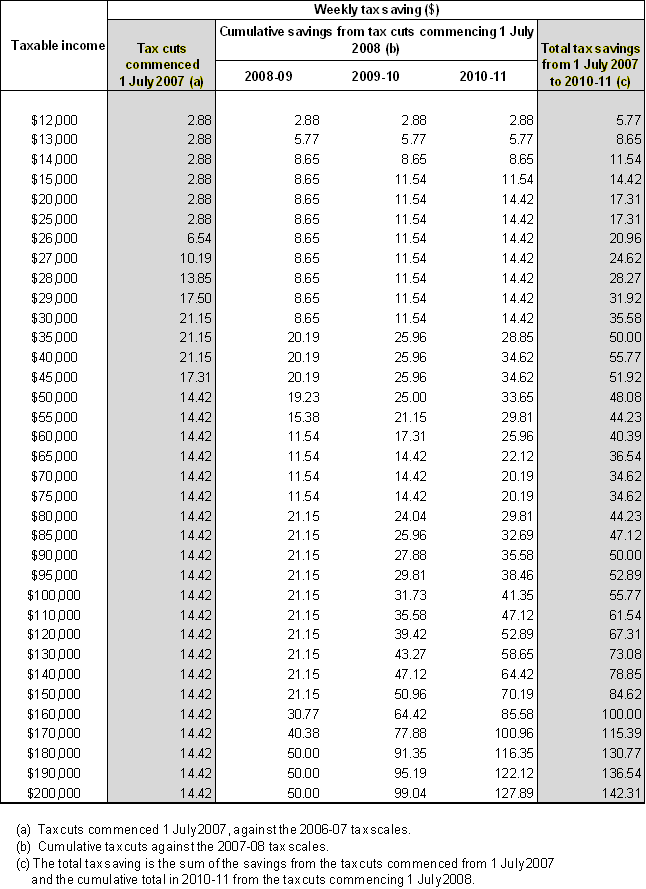
ATTACHMENT B
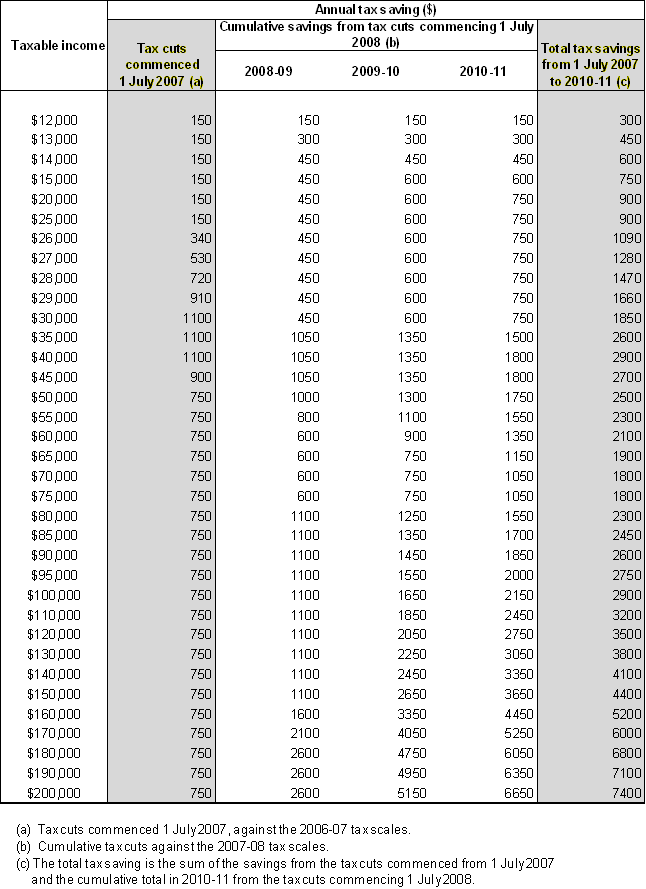
ATTACHMENT C
Improvement in the real disposable incomes and the net tax thresholds for different household types from 1996-97 to 2008-09
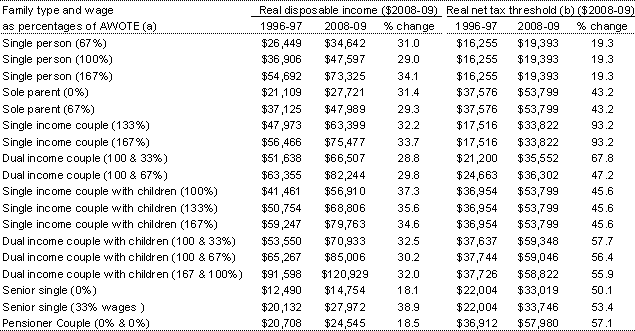
(a) AWOTE is average weekly ordinary time earnings for full-time employees.
(b) The net tax threshold is the private income at which taxes paid exceed cash benefits received. It is determined by the benefits to which each type of family is entitled, on how these benefits are withdrawn and on how personal tax rises for that family type as income rises. There is only one net tax threshold for each family type.
(c) Families with children have two children, one aged 3 the other aged 8.
1 Defined as a resident adult who is not a full-rate pensioner or beneficiary and who has a taxable income greater than the tax-free threshold of $6,000, but does not necessarily have a net tax liability.
